Redis is an open-sourced, BSD 3 licensed, highly efficient in-memory data store that can be easily used as a distributed, in-memory key-value store, cache, or message broker. It is known for being extremely fast, reliable, and supporting a wide variety of data structures, making it a very versatile tool widely adopted across the industry.
Redis was architectured with speed in mind and is designed in a way that it keeps all the data in memory. RAM is volatile though, and Redis keeps the data in the defined storage as well – for cases when it needs to be restarted or started after a critical failure. That’s why you need to minimize those situations and have an observability solution to keep an eye on all the crucial Redis metrics.
In this article we will look at some of the best monitoring tools that will help you run your Redis instances or clusters without unpleasant surprises.
1. Sematext Monitoring
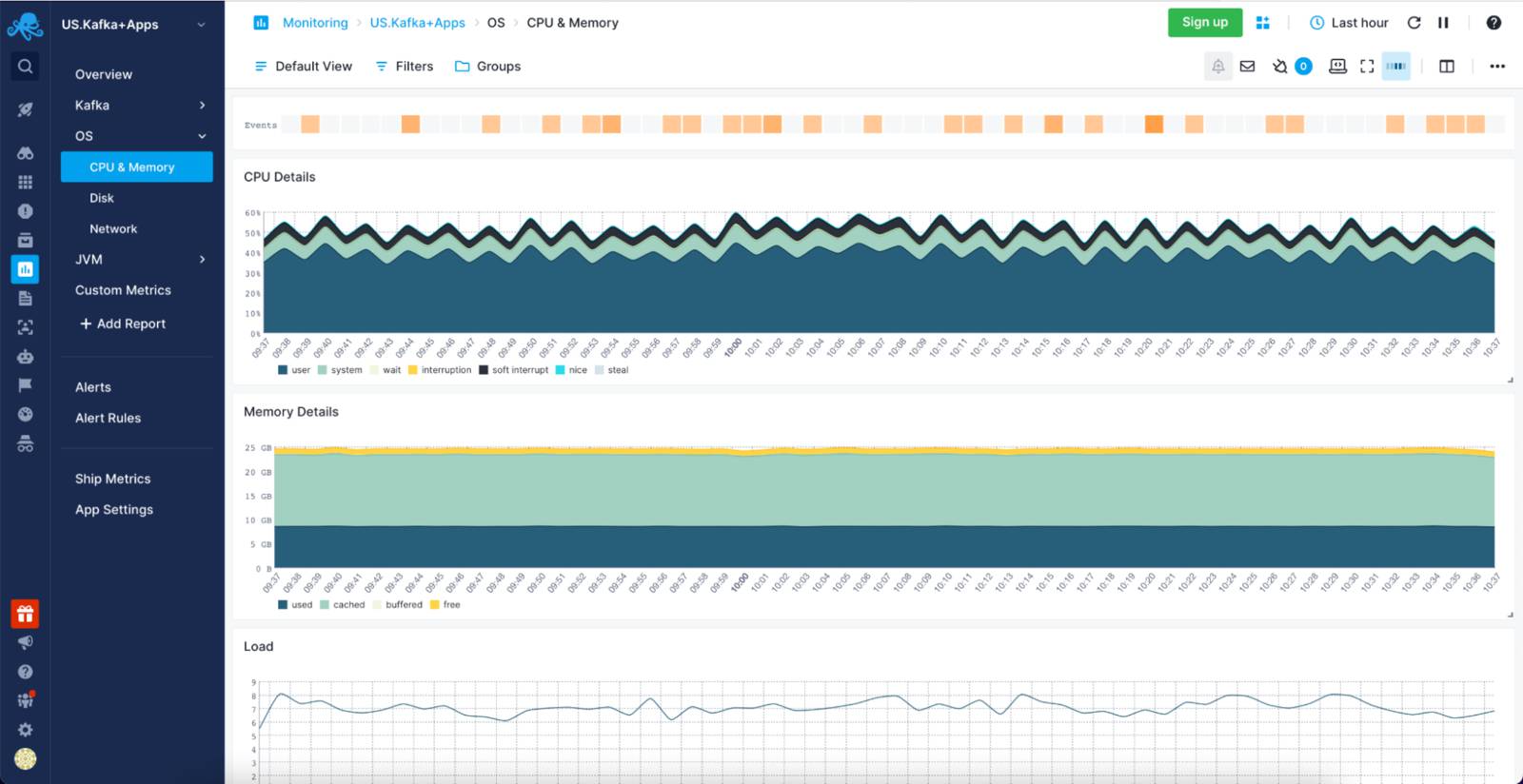
Sematext Monitoring is a full-stack observability platform providing a view into all the necessary metrics for efficient Redis monitoring. Pre-built and ready-to-use dashboards enable instant monitoring, but you can easily customize them to your use case. They expose both Redis metrics and operating system metrics, giving you the full visibility you need to assess system performance or troubleshoot issues. Sematext features powerful alerting that helps you avoid spending time constantly keeping an eye on what is happening with your system.
Features
- Automatic discovery identifies Redis services automatically, enabling hands-off monitoring.
- Flexible alerting with anomaly detection gives you a notification as soon as it is needed and only then limits the alert fatigue.
- Metrics and logs in one tool for even better visibility into your Redis instances.
Pros
- Alerting with anomaly detection and alert importance make it easy to stay informed when important Redis metrics change, such as response rejected connections.
- Pre-built dashboards allow you to start monitoring Redis in seconds without the need to pre-configuring the whole monitoring solution.
- Support for a wide variety of environments makes monitoring Redis easy regardless of your platform of choice – bare metal, virtual machine, or container.
Cons
- Limited support for transaction tracing makes it impossible to view the transaction starting in the frontend and ending in the data store.
Pricing
Sematext’s pricing is simple yet very flexible. Plans depend on your needs and requirements. Redis performance monitoring is metered by the hour, making it suitable for both static and dynamic environments. It starts with $3.6 per host per month for the standard plan and 7 days of monitoring data retention.
Watch the video below to learn more about what Sematext Monitoring can do for you.
2. SolarWinds AppOptics
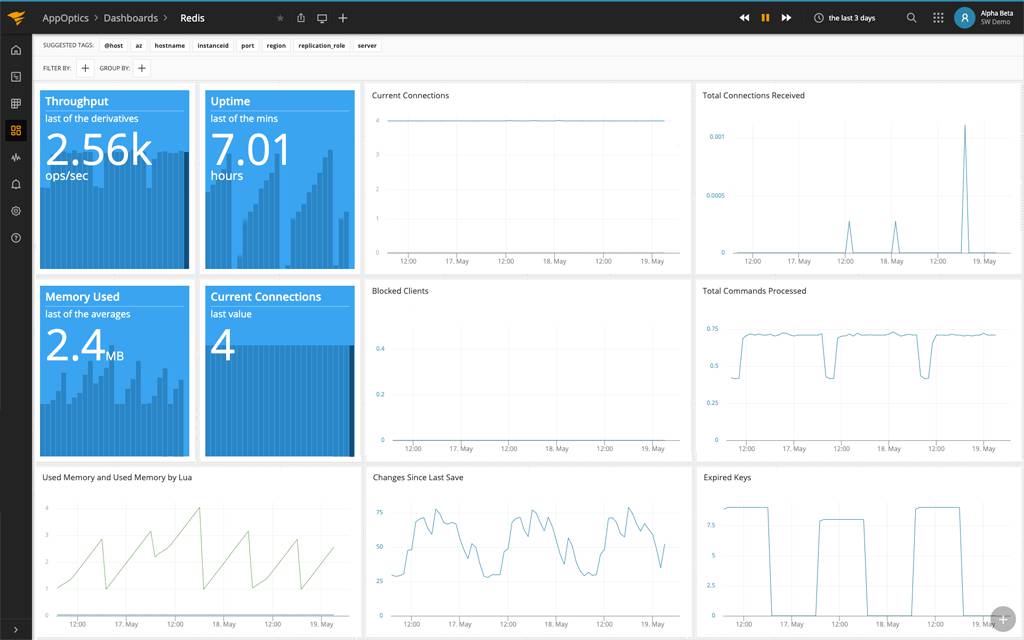
Solarwinds AppOptics is a SaaS application monitoring and infrastructure monitoring tool that provides information about the performance and health of your applications, servers, storage and runtime environments. It supports Redis as one of its integrations, giving you all the metrics you need to ensure it’s up and running at optimum levels. An intuitive tagging system allows you to set up custom tags for different categories of metrics to speed up troubleshooting.
Features
- Key Redis metrics available out of the box, including host system metrics for better visibility.
- Visibility into the host metrics showing you every detail regarding the Redis runtime environment.
- Possibility to monitor various Redis runtime environments such as Docker, Microsoft Azure and Hyper-V.
- Automatic assistance with root cause analysis.
Pros
- Uptime monitoring allows you to quickly diagnose how long your Redis server stays online and healthy.
- Connections, memory and throughput show the load on your Redis instance or cluster.
- Live and historical view over your Redis and infrastructure metrics allowing for efficient real-time troubleshooting and post-mortem analysis.
Cons
- Alerts are more complicated to set up and manage than the described competitors.
Pricing
SolarWinds AppOptics comes in two editions. Infrastructure Monitoring covers all the basic metrics you need to monitor Redis and starts at $9.99 per host a month. If you also want metrics from the applications using Redis, you can opt for the second option, Infrastructure & Application Monitoring, which starts at $24.99 per host per month.
3. SolarWinds Database Performance Monitor
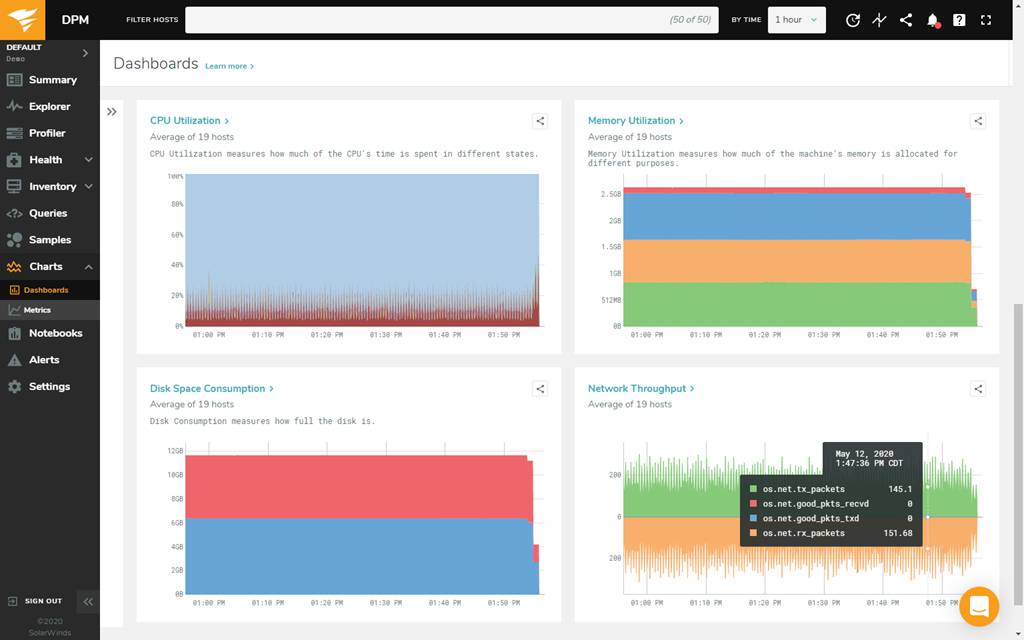
SolarWinds Database Performance Monitor is a monitoring tool designed to help cross-functional teams monitor and optimize many types of databases, including Redis. It provides observability into the key metrics coming from both Redis and the runtime environment, giving you complete visibility into potential performance issues. With SolarWinds top query monitoring and its query-metrics correlation features, you can identify queries that are resource intensive and optimize them. You can use it to optimize your queries with the support for top queries monitoring along with correlation of queries and metrics to identify the queries that are resource intensive.
Features
- Top queries functionality allows finding the most expensive and longest-running queries to identify potential issues quickly.
- Monitor Redis instances running in your own data center, in any of the common cloud providers, or in a hybrid runtime environment.
- Adaptive fault detection helps you identify and resolve problems before they spread across the environment and cause catastrophic cluster outages.
Pros
- Support for all the essential Redis metrics along with memory, performance, network and persistence metrics, and more.
- Designed with collaboration in mind so your cross-functional teams can use the same tool and work together to optimize Redis configuration and performance.
- Completely passive approach to monitoring with in-flight and at-rest data encryption, providing an extremely fast and secure way to monitor Redis instances.
Cons
- Alerting engine could be more flexible and allow alerts on metrics over time.
Pricing
At the time of writing there was no clear pricing available. You can get a quote from a sales representative or use the interactive form available on their solutions online quote page.
4. ManageEngine Applications Manager
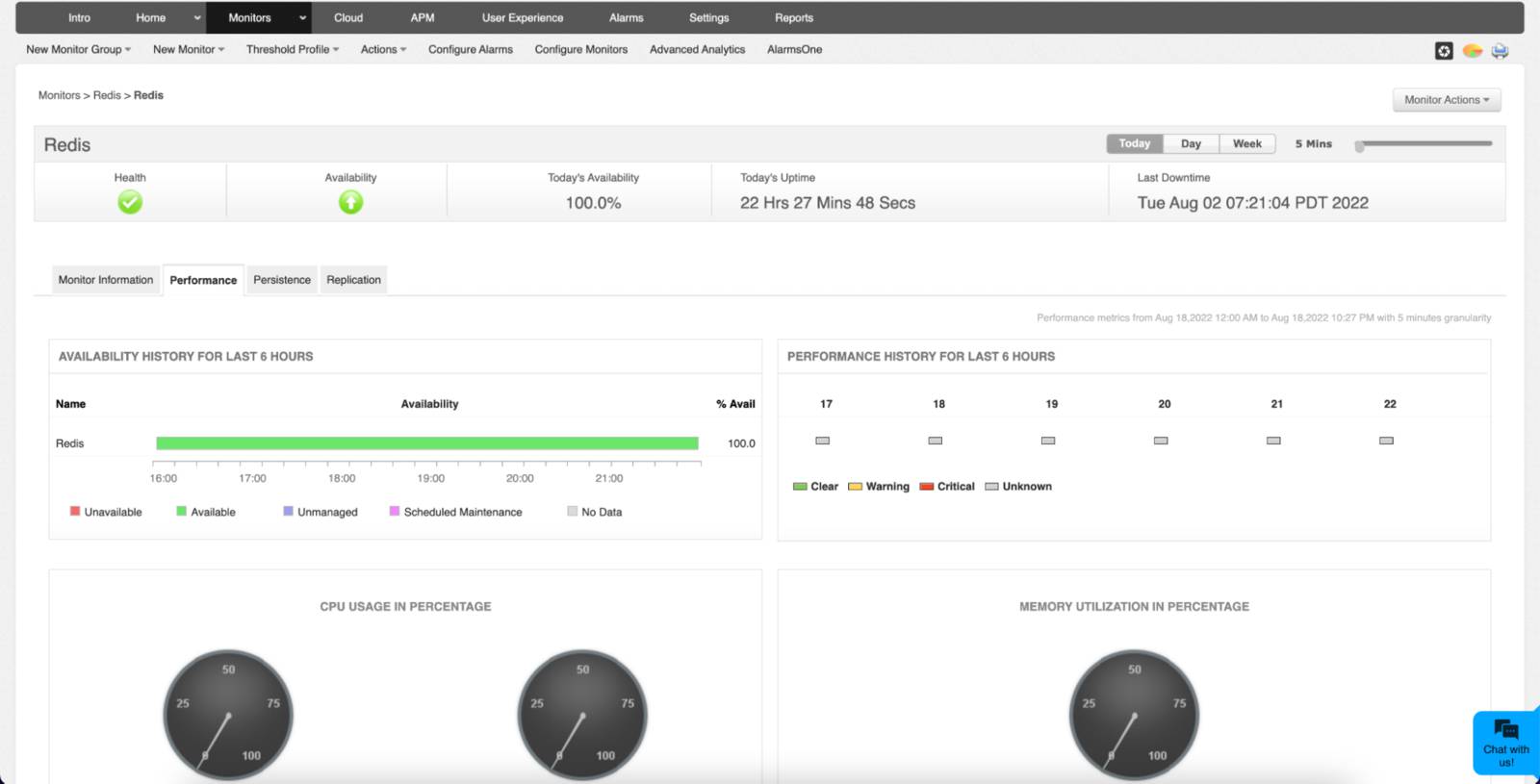
ManageEngine Applications Manager is a unified application performance monitoring solution that offers Redis monitoring whether it runs on your own on your bare-metal machine or in the cloud provider of your choice, including Amazon Web Services, Microsoft Azure, Google Cloud Platform, and OpenStack. Thus, it makes it easier for you to track the health of your clusters without worrying about the runtime environment. It provides support for a large number of apps and platforms, making it one of the go-to tools for monitoring Redis performance and the whole environment.
Features
- Alerting engine with notifications support to notify you of issues with your Redis instance or cluster.
- The Fault management system enables you to quickly get to the root cause of the problem.
- Redis persistence monitoring ensures you can always get back to a healthy environment even after a Redis crash.
Pros
- All necessary and required Redis metrics are available out of the box, including memory utilization and fragmentation, CPU usage, connections, and more.
- Customizable dashboards for better visibility, allowing you to focus on crucial Redis metrics depending on your needs.
- Support for Docker and Kubernetes environments for efficient monitoring of your Redis instances running in containerized, dynamic environments.
Cons
- Lack of support for Redis metrics and Redis logs correlation.
- Interface feels heavy compared to some competitors.
Pricing
ManageEngine Applications Manager has two pricing tiers – Professional and Enterprise with a free tier of up to 5 monitors available. The pricing depends on your monitoring needs, the number of monitors and the number of users that are using the platform. Both depend on the selected version, the number of monitors, and the number of users using the product.
5. Datadog
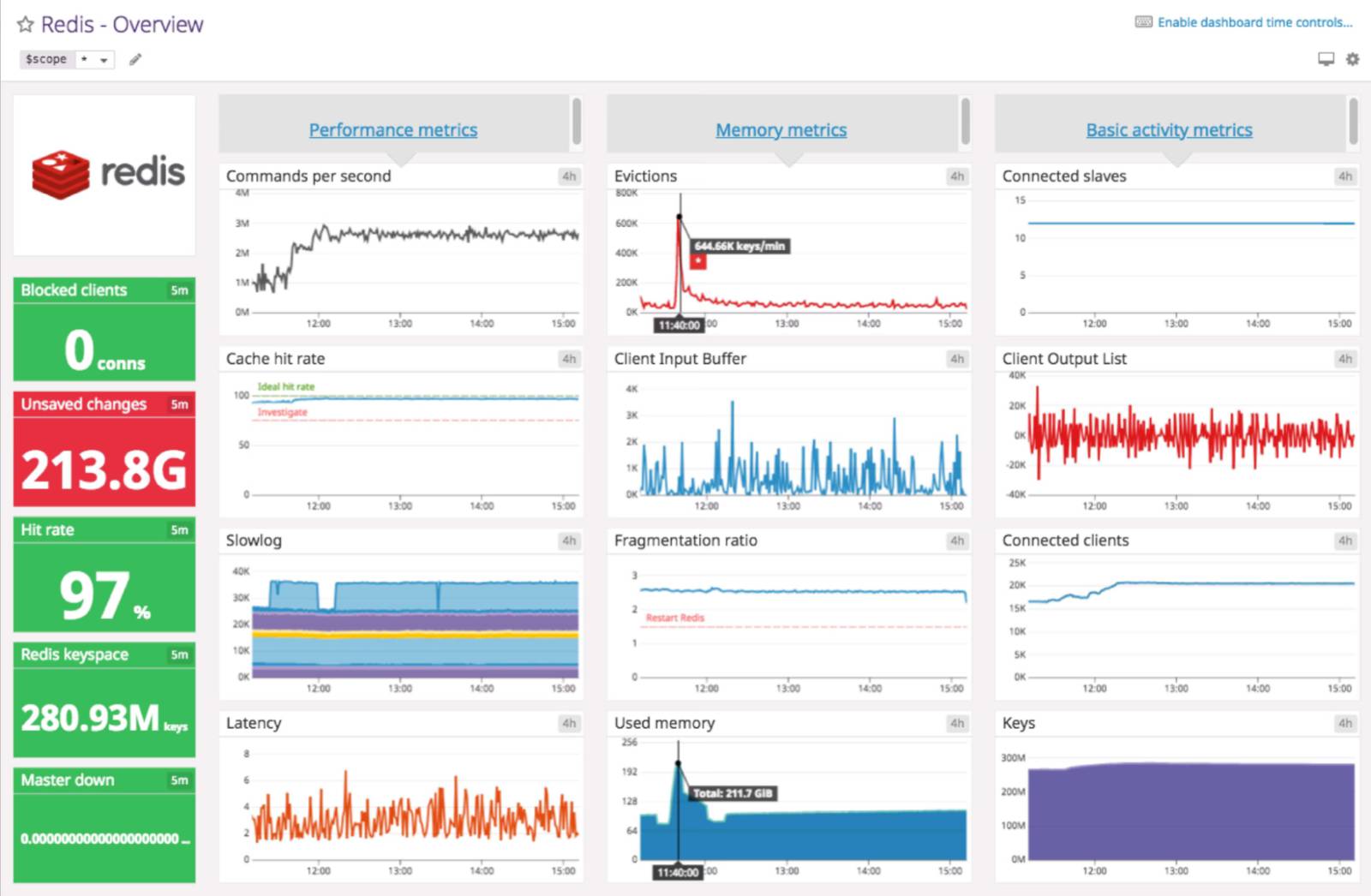
Datadog is an all-in-one software-as-a-service monitoring solution with out-of-the-box Redis monitoring capabilities. It features alerting with anomaly detection powered by sophisticated machine learning capabilities – this reduces alert fatigue, delivering only the most critical information about your Redis clusters. The default configuration provides everything you need to monitor Redis, but you also have the option to customize it to provide additional metrics.
Features
- Overall Redis metrics, such as performance-related metrics, memory usage, blocked clients, disk persistence, and key eviction, give an overview of its status and how fast the requests are.
- Alerting with anomaly detection powered by machine learning.
- Integration with Redis logs and traces for full visibility.
Pros
- Out-of-the-box Redis monitoring dashboards that allow metrics, logs and traces correlation.
- Network and host components monitoring for complete visibility into the environment that your Redis instances are running in.
- Replication metrics for monitoring Redis clusters.
Cons
- The initial installation process can be overwhelming if you need a customized configuration that exposes data beyond what is provided out of the box by the Redis monitoring dashboards.
Pricing
Datadog’s pricing depends on what part of the solution you need for your use case. For basic Redis monitoring there’s application performance monitoring. This plan starts at $31/host per month when billed annually or $36/host per month when billed monthly.
Want to see how Sematext stacks up? Check out our page on Sematext vs Datadog.
6. New Relic
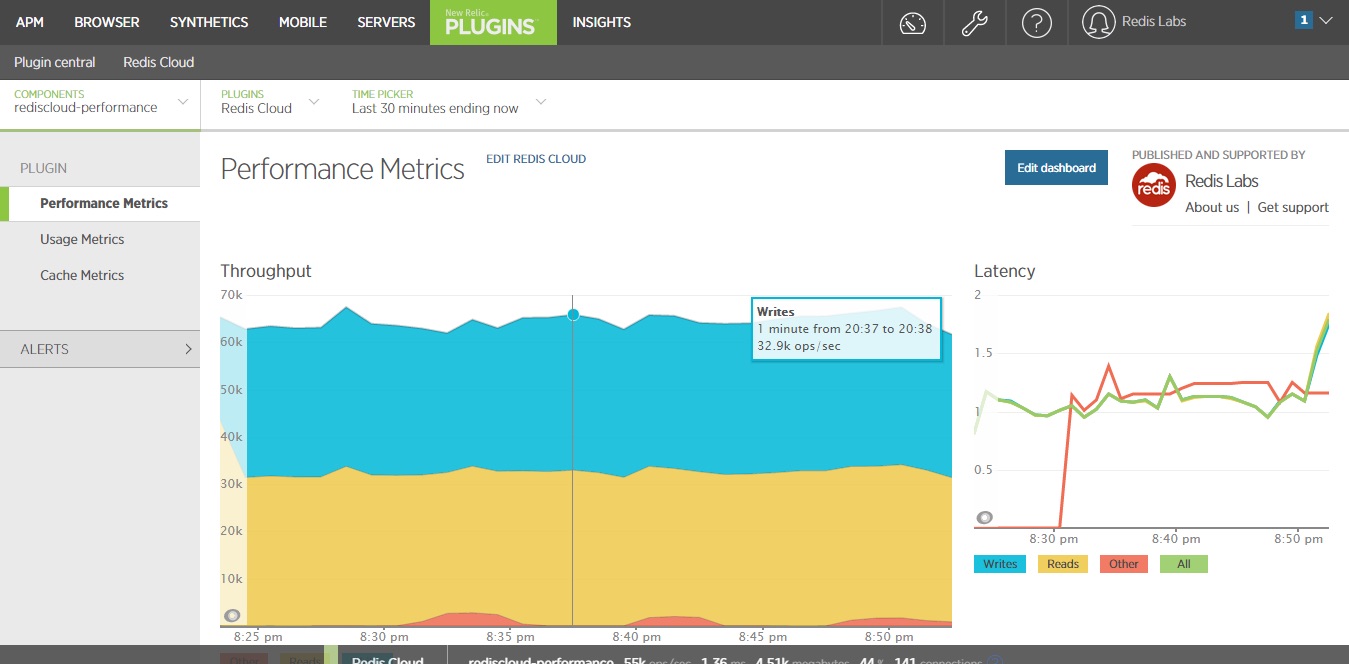
New Relic is an end-to-end monitoring software that integrates with Redis. The solution is available in a software-as-a-service model. It provides Redis monitoring capabilities with alerting anomaly detection and the powerful New Relic Query Language for custom dashboarding. Together with root cause analysis, the solution provides everything needed to have efficient Redis monitoring.
Features
- Integrated alerting with anomaly detection notifying you when metrics don’t behave as expected.
- Rich and powerful query language – NRQL for custom visualizations that are not part of the pre-created dashboards.
- Log centralization and analysis allow you to send not only Redis metrics but logs as well.
Pros
- Application Performance Monitoring with custom dashboarding and full Redis support with pre-configured visualizations.
- Integration with most known cloud providers such as AWS, Azure, and Google Cloud Platform makes it easy to monitor Redis on those platforms.
- Support for bare metal, virtual machines and orchestrated environments such as Kubernetes.
Cons
- The initial setup for the monitoring agent is quite manual compared to the competing solutions, especially if not running on Kubernetes or ECS.
Pricing
User and data-based pricing are available depending on the needs. The user type determines the available features and the amount of data you can send without an additional fee. For example, the Standard plan comes with 100GB of data/month for free and $0.3/GB after that and includes up to 5 users with full access to the monitoring solution and an unlimited number of basic users without access to features such as APM, infrastructure monitoring, synthetics, serverless monitoring, and more.
Want to see how Sematext stacks up? Check out our page on Sematext vs New Relic.
7. Dynatrace
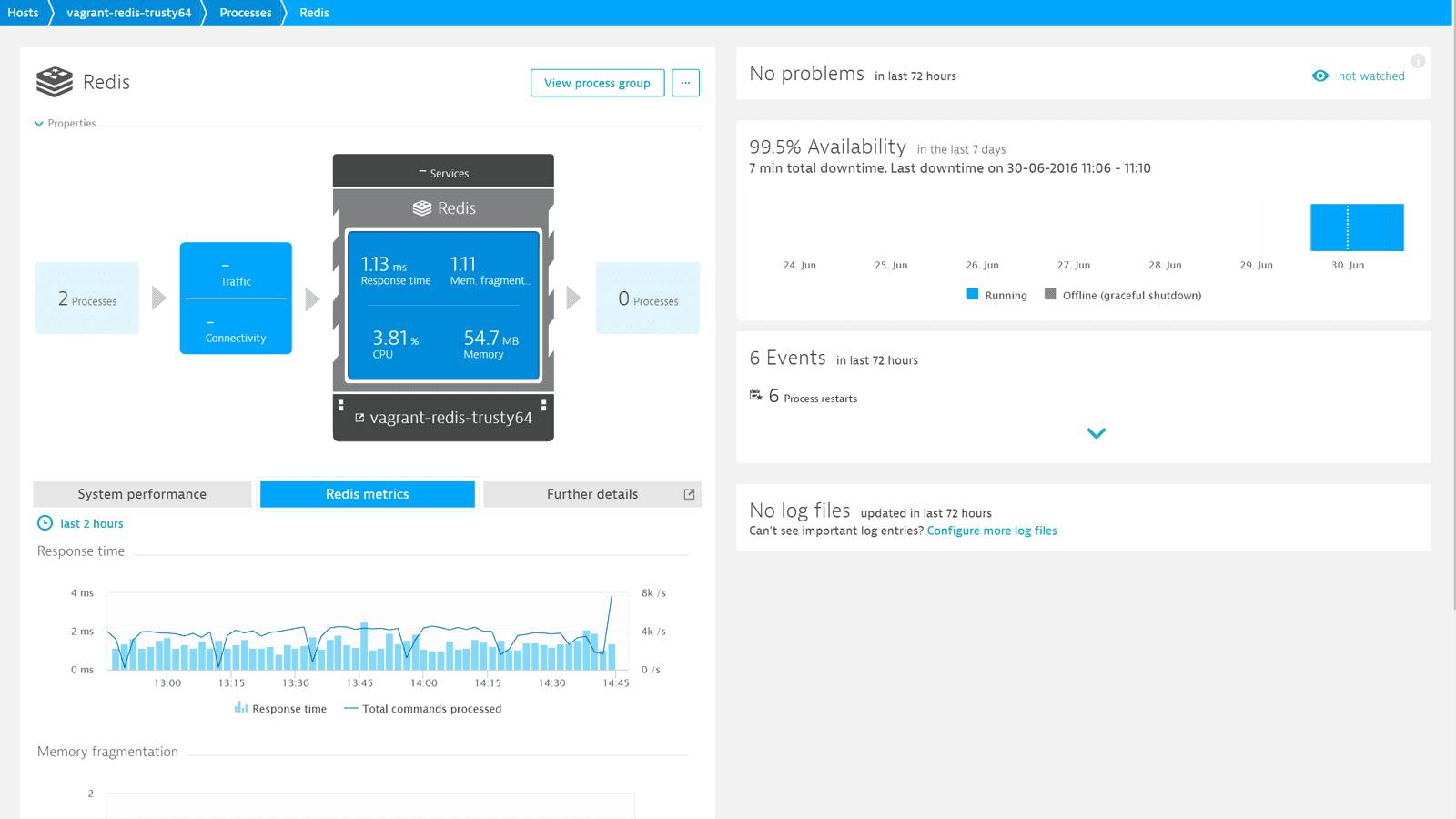
Dynatrace is a full-stack monitoring tool that provides a powerful and user-friendly approach to monitoring your Redis instances. It doesn’t matter what environment you are using – Dynatrace can handle all of the common runtime environments like Docker, Kubernetes and OpenShift, as well as popular cloud providers including Amazon Web Services, Google Cloud Platform and Microsoft Azure. Combining that with powerful alerting and versatility gives a powerful tool for Redis monitoring and more.
Features
- Full visibility into response time, memory fragmentation, cache hit ratio and more gives you everything required for Redis monitoring.
- Out-of-the-box Redis monitoring dashboards and alerting.
- Automatic Redis topology discovery makes monitoring whole Redis clusters very easy.
Pros
- Slow log monitoring features help detect slow Redis requests faster.
- AI-powered anomaly detection with root cause analysis increases the speed at which you can solve the problems with your Redis environment.
- Redis and operating system metrics show you top-to-bottom information needed to diagnose Redis-related problems.
Cons
- The number of features may be initially overwhelming.
- Can quickly become expensive for Redis because of memory-based pricing.
Pricing
Dynatrace pricing depends on the features that you need. Application performance monitoring pricing depends on hosts and the amount of memory available on a host. Each 16GB is a host unit, and the price is calculated using the number of host units in an hour. It can become quite expensive for large Redis clusters.
Want to see how Sematext stacks up? Check out our page on Sematext vs Dynatrace.
8. Beats & Elasticsearch
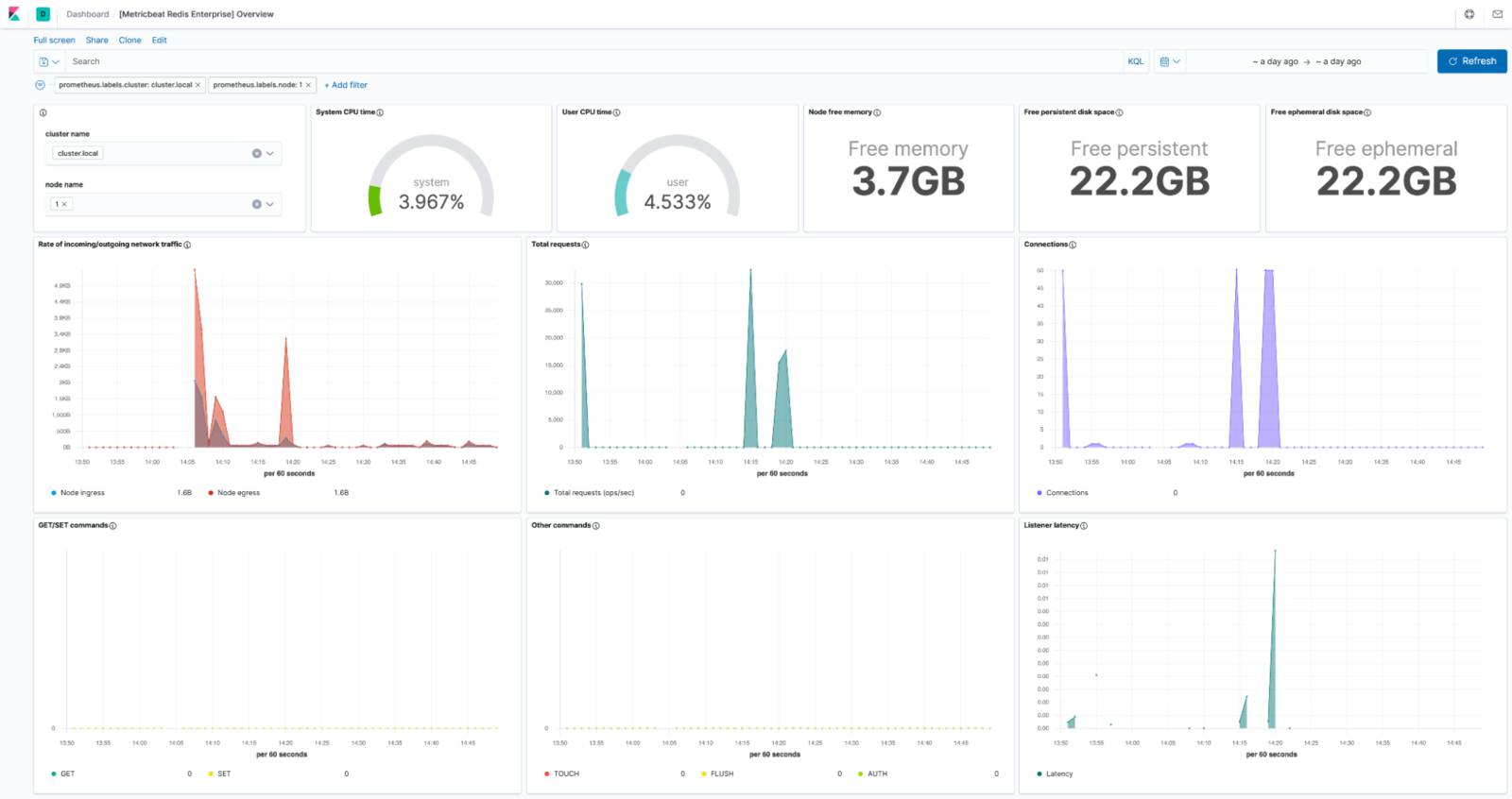
The Elasticsearch-Beats combination is one of the most popular solutions available for monitoring, log analysis and more, with Redis monitoring features. Highly scalable, it supports virtually unlimited amounts of data for all your current and future Redis clusters, allowing you to reach out for historical data whenever you need it. When combined with Kibana, you get extensive visualization and get to create dashboards that contain metrics coming from Redis and other applications and infrastructure elements. Combine that with logs for even higher visibility and quicker issue-cause analysis.
Features
- Full stack monitoring solution combining logs and metrics for full visibility of your infrastructure elements, including Redis.
- Highly available and scalable alerting functionality with a wide variety of destinations with alerts suppression for managing your Redis metrics-based alerts.
- Powerful dashboarding capabilities allow you to visualize your metrics coming from various infrastructure elements including ones coming from Redis.
Pros
- Mature, well known and backed up by a large community.
- Support for various languages for working with metrics, including SQL and Elasticsearch DSL.
- Easy and straightforward configuration.
Cons
- When dealing with large installations, you need to keep maintenance of your Elasticsearch cluster in mind – the cluster that you will keep your data in needs to be up and running. That means that your team will need to maintain it and you need hardware to run it.
- The free Elastic License 2.0 doesn’t allow exposing parts of the Elastic functionality as a SaaS product.
Pricing
Elasticsearch and Beats are free if you don’t provide your services as the hosted or managed solution where the Elastic stack is available to users as part of the service itself.
9. Site24x7
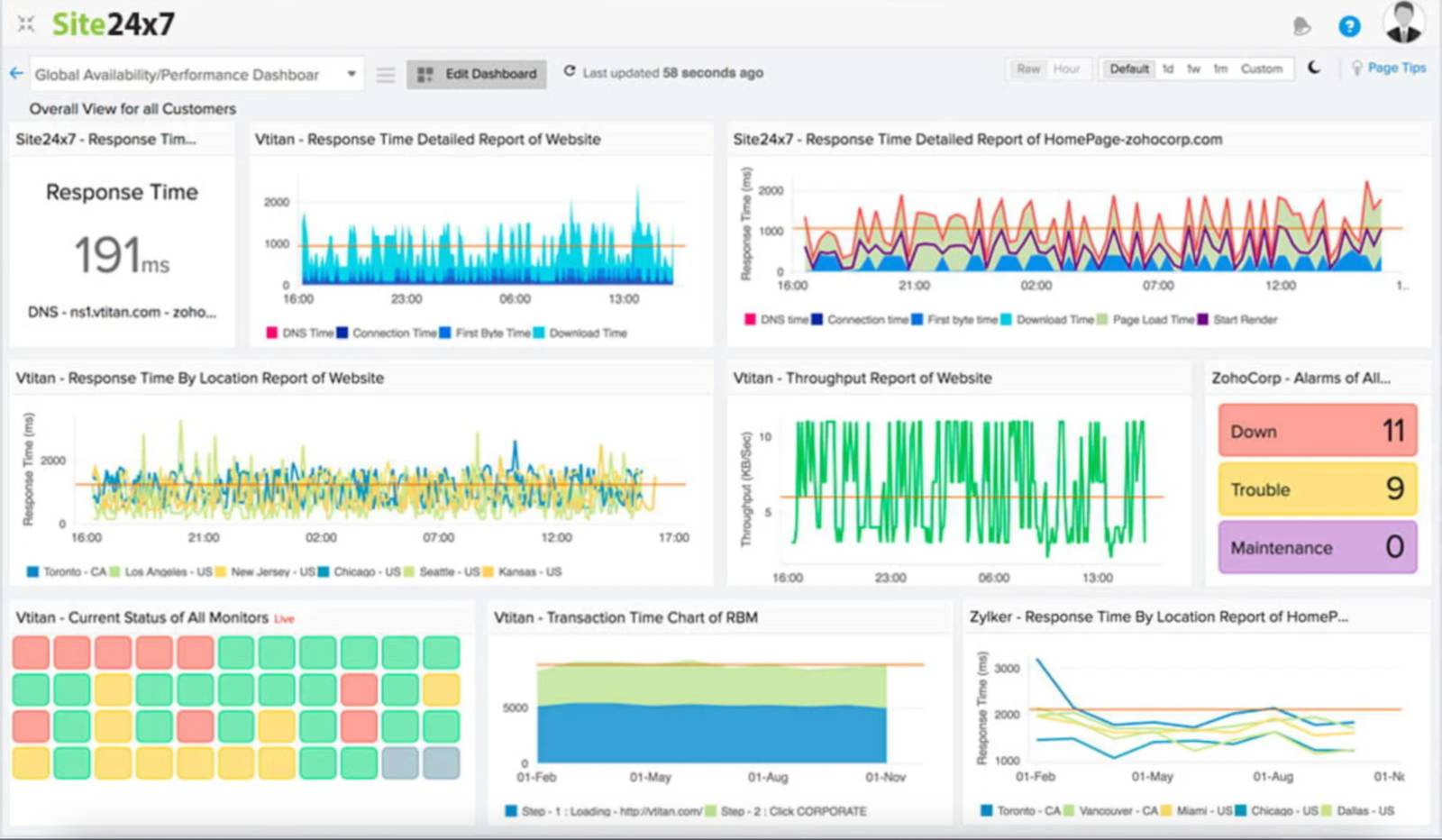
Site24×7 is a cloud monitoring tool that provides all the necessary metrics out of the box for Redis monitoring. Besides Redis instances and clusters, it can track the performance of over 50 additional technologies running inside your infrastructure, including commonly used ones such as MySQL. The alerting engine features advanced rules that help you to limit alert fatigue and get instant insights into the root cause of the bottleneck.
Features
- Out-of-the-box support for all the necessary Redis metrics.
- Supports Redis monitoring regardless of the platform it runs on – Windows, Linux, or any cloud provider.
- Powerful alerting engine with advanced rules system for better and more narrowed alerts.
Pros
- Quick and easy agent installation.
- Easy-to-build dashboards enable custom views into each component of your infrastructure, including crucial Redis metrics such as memory utilization, connection metrics, and CPU usage.
Cons
- The APM plan is not enough to get full visibility into Redis and the infrastructure behind it.
- Requires manual agent configuration modification to get metrics that are not supported out of the box.
- Server monitoring support for a limited number of technologies.
Pricing
Pricing varies depending on what parts of the product you plan on using. When billed annually, the APM pricing plan starts at $35 per month for up to 3 applications, 40 servers and up to 500MB of logs. If you want visibility into the metrics of the servers Redis is running on, you need infrastructure monitoring, whose annual plan starts at 9 euros per month for up to 10 servers, 500MB of logs, and 100K page views for a single site.
Want to see how Sematext stacks up? Check out our page on Sematext vs Site24x7.
10. Opsdash
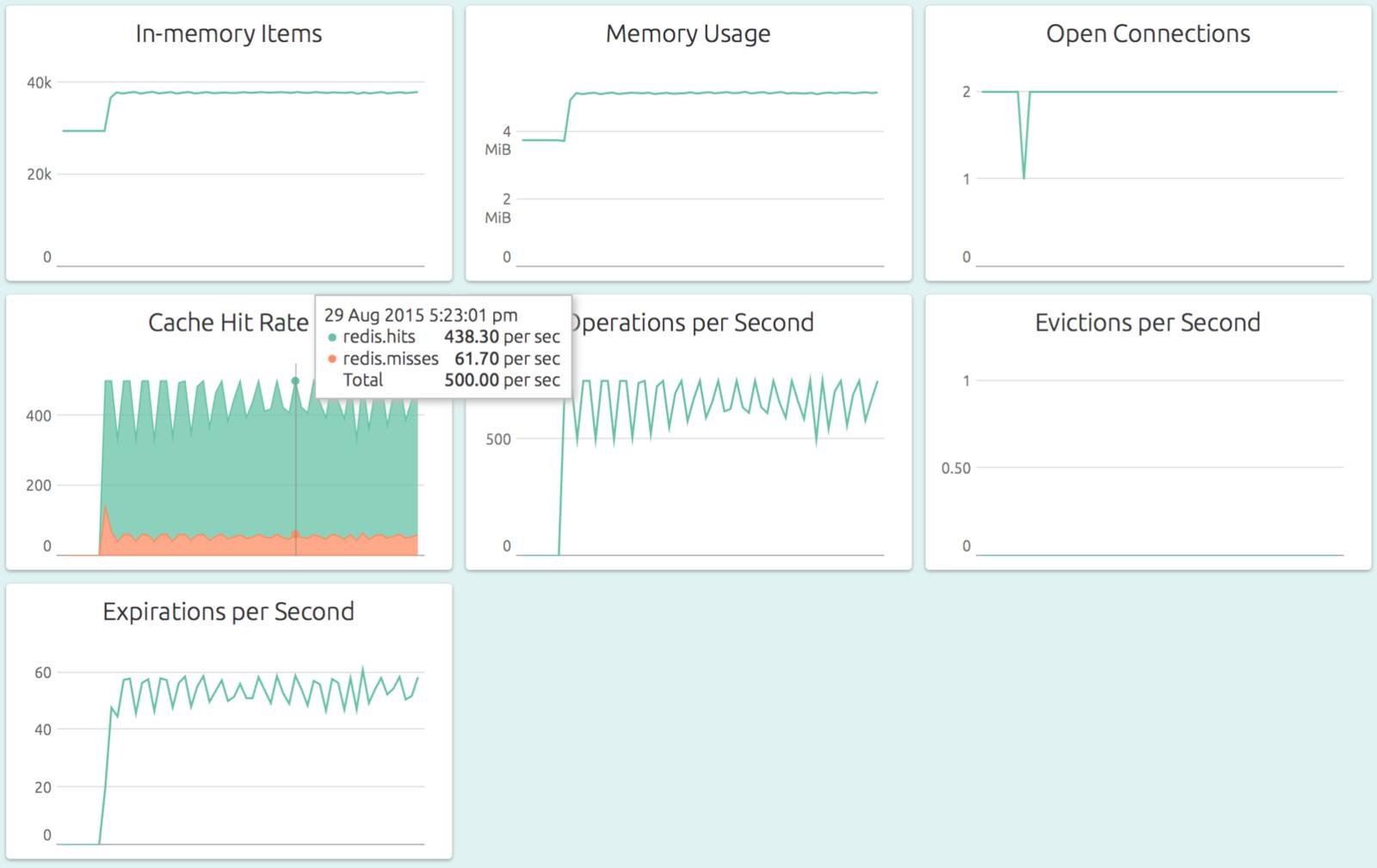
OpsDash is a self-hosted monitoring solution with Redis integration available out of the box. It features pre-configured monitoring dashboards that instantly allow you to start monitoring critical Redis metrics. You can use rule-based alerting to get notified for events matching your set of rules and deliver the notifications to one of the available ChatOps integration.
Features
- Rule-based alerting with ChatOps integration such as Slack, HipChat, PagerDuty, and more for your Redis-related alerts.
- Services and database monitoring not only for Redis but also other popular infrastructure elements such as Docker, Apache, Nginx, MySQL, PostgreSQL, Elasticsearch and more.
Pros
- Out-of-the-box dashboards with all the Redis metrics needed to ensure the health and performance of your clusters, including in-memory items, cache hit ratio, memory usage, latency.
- Agent support for statsd allows additional custom metrics support if needed.
Cons
- Lack of anomaly detection in the alerting capabilities
Pricing
The OpsDash pricing is very straightforward – you can monitor up to 5 servers and 5 services for free. If you need to go above – you pay $1/month for a server with an unlimited number of services.
11. Nagios
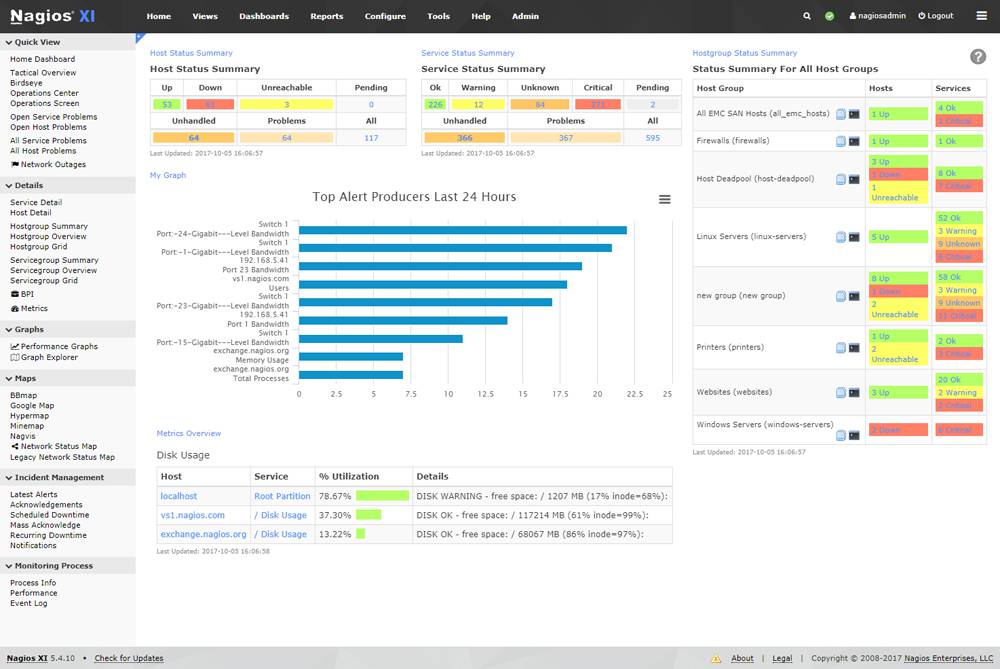
Nagios is one of the oldest, most well-known and established monitoring tools available on the market, having gathered a large, dedicated community to back it up. Due to its extensible architecture, it supports a wide variety of technologies, including Redis. It is not only a monitoring solution for your Redis instances, but also for your whole infrastructure and the applications running it. Nagios offers open-source and commercial enterprise solutions – namely, Nagios Core and Nagios XI with the former having less capabilities.
Features
- Powerful scripting API helps you monitor virtually anything and adjust monitoring to your needs.
- Rich reporting capabilities include SLAs reports and performance-related insights of the whole environment status, including Redis.
- Alerts with escalation capabilities ensure that the notification about swapping problems will be delivered instantly to the appropriate people in your team.
Pros
- Full monitoring solution for all infrastructure elements makes it a single place to go when troubleshooting Redis issues and more.
- Mature, open-source solution with a user-friendly GNU GPL license with a large community.
Cons
- Requires an external plugin to monitor Redis and provide all the necessary metrics; finding the right one may involve trial and error.
- To get full visibility into your Redis clusters, you need multiple plugins and a lot of manual work with no one-click installers available.
Pricing
You have free and unlimited access to Nagios Core. With more features to offer, Nagios XI has two different pricing tiers – Standard, which starts at $1995 per 100 nodes, and Enterprise, which starts at $3495.
Get Started with Redis Monitoring
Performance is very important in modern computing. In the world of constant competition, your user may not want to wait endlessly for a page to be displayed, for search results to show, or for the cart to be finalized. Redis helps you achieve your performance goals because of its versatility, speed and feature set. But installing and using Redis in your application is not everything. You need to ensure your Redis instances are healthy and perform well without any hardware or software bottleneck. To help you achieve that, you will need a good Redis monitoring tool that gives you a complete view of your instances. You will need alerts delivered to the right place, anomaly detection and a clear picture of all the crucial Redis metrics. One solution that provides all of that is Sematext Monitoring with its Redis monitoring integration. Give it a try! Start the 14-day free trial to see if it’s the right solution for you.